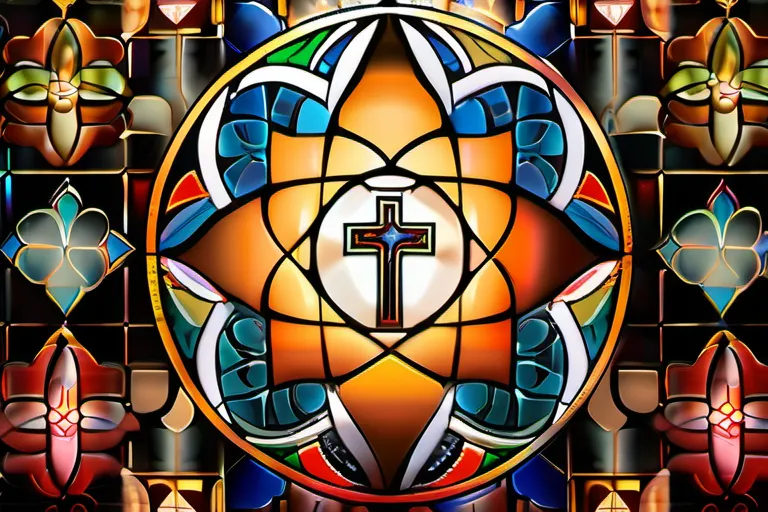Exploring the Varieties of Religious and Spiritual Traditions Around the World
In this comprehensive guide, we delve into the fascinating world of non-Christian beliefs, comparing and contrasting them with other spiritual traditions. From ancient religions to modern-day practices, we’ll explore the unique aspects that define each belief system.
The Basics: Defining Non-Christian Beliefs
Imagine walking into a vast library where every book represents a different belief system—each one unique yet interconnected like the branches of a great tree. One day, you decide to explore the section dedicated to non-Christian beliefs. How do they differ from Christianity? Are these differences just superficial or do they go much deeper?
Non-Christian beliefs often trace their origins back to ancient times, unlike Christianity which has a specific historical founder and date of origin. Consider animism, the belief that spirits exist in natural objects such as rocks, rivers, and trees. It’s like seeing nature not just as part of your environment but as infused with life and consciousness.
Another key difference lies in their view of deities or gods. Christianity usually revolves around a single supreme God, whereas non-Christian beliefs often involve a pantheon of multiple gods and goddesses. For example, in Hinduism, the concept of many manifestations of a single divine force, known as Brahman, is central. It’s like having one parent who takes different forms to guide their children—Mother Nature, Father Time, or even a protective deity like Ganesha.
Practices also vary widely in non-Christian beliefs. Many involve rituals and ceremonies that seek to honor the divine through actions such as sacrifices, offerings, and festivals. In contrast, Christianity often focuses on prayer, worship, and sacraments. A Muslim performing a pilgrimage to Mecca is like undertaking a spiritual journey to the heart of their faith, while a Buddhist engaging in meditation seeks inner peace through mindfulness.
The paths to understanding non-Christian beliefs require an open mind and a willingness to step outside familiar boundaries. Each belief system is a lens that offers unique insights into humanity’s quest for meaning and connection. So, as you explore this vast library, ask yourself: What might I learn from these diverse traditions?
Ancient Religions: Exploring Paganism, Hinduism, and Buddhism
Ancient Religions: Exploring Paganism, Hinduism, and Buddhism
Have you ever wondered how different ancient beliefs shaped our world? In this journey through time, we delve into the rich tapestry of non-Christian religions that have left an indelible mark on history. Let’s start with Paganism, a term often used broadly to encompass a variety of polytheistic traditions before the spread of Christianity.
Imagine walking through a dense forest, surrounded by ancient stone circles and intricate carvings. These are the physical remnants that hint at the deep spiritual beliefs that once thrived here. Paganism is not just about worshipping nature; it’s about harmony with the natural world, where every aspect of life has a divine presence.
Hinduism, on the other hand, offers a complex and multifaceted worldview that dates back thousands of years. It is often called the oldest living religion in the world, and its teachings span vast philosophical and spiritual landscapes. Can you imagine the intricate web of gods and goddesses that Hindus worship? Each deity represents a different aspect of life, from creation to destruction.
In Buddhism, we find a path that focuses on achieving inner peace through meditation and ethical living. It emerged as a response to the suffering seen in life, offering a way out of the cycle of rebirth (samsara). Is it not fascinating how this religion emphasizes individual enlightenment rather than worshiping deities?
These ancient traditions offer us a glimpse into the diverse ways humans have sought to understand and connect with the divine. Each belief system is like a window, letting in different hues of spirituality that enrich our understanding of humanity’s quest for meaning.
By exploring Paganism, Hinduism, and Buddhism, we uncover layers of history, culture, and philosophy that continue to influence modern thought. These beliefs are not just relics of the past; they resonate with contemporary issues, making them relevant in today’s world.
Modern Beliefs: Examining Islam, Judaism, and Other Contemporary Faiths
Imagine stepping into a world where beliefs are as diverse as the colors in a rainbow. After exploring ancient religions like paganism, Hinduism, and Buddhism, we now turn our focus to modern belief systems that have emerged since Christianity. In this journey, we will delve into Islam and Judaism, two of the world’s major monotheistic faiths, as well as touch upon other contemporary religions.
How does Islam differ from Christianity? Both share a common heritage in Abrahamic traditions but diverge significantly in their teachings and practices. For instance, while Christians believe in the Trinity, Muslims adhere strictly to the belief in one God (Allah) without any associates or partners. This difference is reflected in the daily prayers and religious observances of both faiths.
Then there’s Judaism, a religion with deep historical roots tracing back over 3000 years. How does it compare to its cousin religions? Unlike Christianity, Judaism does not consider Jesus as a messiah; instead, it focuses on the covenant between God and Abraham and the commandments of the Torah.
Other contemporary faiths are equally fascinating. Take Baháʼí Faith, for example, which emerged in the 19th century in Iran. It blends elements from various world religions, aiming to promote unity among all people. How does this blend of beliefs impact its followers’ daily lives and global outreach?
These modern belief systems offer a rich tapestry of spiritual practices and theological ideas. Each has unique rituals, scriptures, and ethical codes that shape the way their adherents view the world and interact with others.
By exploring these diverse faiths, we gain a deeper appreciation for the complex interplay of history, culture, and spirituality. Just as every snowflake is unique yet part of a greater winter wonderland, so too are these religions distinct yet interconnected in their shared quest to understand the divine.
Comparing and Contrasting: Similarities and Differences Among Beliefs
When delving into the diverse landscape of non-Christian beliefs, one can’t help but be struck by the rich tapestry of traditions that exist beyond the familiar confines of Christianity. How do these belief systems intersect and diverge from each other? Let’s take a closer look at some key aspects that make them unique.
Firstly, consider the concept of soul. In many non-Christian beliefs, such as Hinduism and Buddhism, the soul is often seen as an eternal entity that undergoes reincarnation. This is in stark contrast to Christianity, where the belief in a single-life soul that finds its ultimate destiny either in heaven or hell is prevalent. Can we really believe that the path of spiritual evolution through rebirth is any less meaningful than the Christian doctrine of one life and one afterlife?
Another intriguing aspect is the role of deities. Polytheistic religions like ancient Greek and Roman mythology, as well as contemporary traditions such as Shinto in Japan, highlight a pantheon of gods with distinct roles. This is different from the monotheism found in Judaism, Christianity, and Islam, where there is only one god. How do these multiple deities influence daily life and religious practices? Is it possible to worship many gods without losing the sense of unity they provide?
In terms of rituals, non-Christian traditions often involve elaborate ceremonies that are deeply intertwined with nature and community. For example, in indigenous beliefs around the world, rituals are performed to honor the spirits of ancestors and natural elements like rivers and mountains. These practices serve as a connection between the physical and spiritual realms. How do these rituals differ from the more formalized church services found in Christianity? Do they offer a more holistic approach to spirituality?
The concept of afterlife is another area where non-Christian beliefs vary significantly. In Taoism, for instance, the soul may travel through various realms based on one’s actions in life, while Zoroastrianism emphasizes the importance of good thoughts, words, and deeds leading to a better afterlife. How do these views shape the way people live their lives? Do they provide a different perspective on morality and ethics?
Lastly, let’s consider philosophical perspectives. Philosophies like Confucianism in East Asia emphasize social harmony and ethical living, while Daoism focuses on the natural flow of life. These philosophies offer profound insights into human behavior and societal structure that are distinct from Western philosophical traditions. How do these Eastern philosophies impact personal and communal values?
As we explore these differences, it becomes clear that non-Christian beliefs offer a wealth of diverse perspectives on the human experience. Each tradition brings its unique lens to understanding the world and our place in it.
The Role of Rituals and Practices in Non-Christian Beliefs
Imagine stepping into a temple where you see intricate rituals being performed, a stark contrast to the familiar Christian practices you might be accustomed to. How do these rituals function in non-Christian beliefs? Are they merely symbolic gestures, or do they carry profound meanings and purposes?
Rituals in non-Christian traditions often serve as a bridge between the physical world and the spiritual realm, much like how a gateway can connect two different dimensions. For instance, in Hinduism, rituals such as puja involve offerings to deities, which are believed to maintain harmony and balance in the universe. These practices are not just about worship; they are seen as actions that interact with cosmic forces.
Consider the significance of the circumcision ceremony in Judaism. It is a deeply embedded practice that signifies covenant and identity, much like a map that guides one’s spiritual journey through life’s challenges. The purpose goes beyond physical ritual; it involves a commitment to follow a set of moral and ethical principles.
In Buddhism, the meditation practice serves as both a tool for personal development and a means to achieve enlightenment. It is an internal journey, a voyage within oneself to find peace and understanding. This practice emphasizes mindfulness and awareness, reflecting the belief that true knowledge comes from self-reflection.
The diversity in rituals across non-Christian beliefs highlights how culture heavily influences spiritual practices. Each ritual is embedded with local customs, historical contexts, and philosophical beliefs, making them unique yet interconnected in their quest for divine connection. Understanding these rituals helps us see the world through a different lens, one that values the profound connections between humans and the transcendent.
The Impact of Non-Christian Beliefs on Society and Culture
Have you ever wondered how non-Christian beliefs have influenced society and culture throughout history? These diverse belief systems, often intertwined with local customs and traditions, have left indelible marks on the fabric of human civilization. How did Buddhism shape East Asian societies? What role does Hinduism play in shaping Indian social structures today?
Let’s delve into the profound impact non-Christian beliefs have had and continue to have on contemporary life. Imagine a world where every culture is a tapestry woven from threads of different faiths; each belief system adding its unique hue, texture, and pattern.
- Buddhism: In countries like Japan and Thailand, Buddhism has not only influenced religious practices but also social norms. Consider the concept of sangha, the community of believers, which parallels the idea of a supportive social network in modern society.
- Hinduism: The caste system, deeply rooted in Hindu tradition, has historically structured Indian society. Even today, despite legal reforms, remnants of this system continue to influence social interactions and opportunities.
- Islam: In the Middle East and parts of Africa, Islamic principles have shaped economic systems, legal frameworks, and community structures. The concept of Zakat, or charitable giving, is not just a religious duty but also an integral part of economic life.
- Judaism: While predominantly practiced in Israel and among diaspora communities, Jewish beliefs have significantly influenced Western ethical thought and the development of democratic principles.
These belief systems often act as guides for moral and social behavior. How do you think these ancient teachings influence daily life today? Are there ways in which non-Christian beliefs can contribute to modern societal challenges such as environmental sustainability, social justice, and community building?
The interplay between non-Christian beliefs and society is a complex and fascinating subject. As we explore further, remember that each belief system offers unique insights and solutions to the questions of human existence and interaction.
Conclusion
 By gaining a deeper understanding of these diverse beliefs, we can foster greater empathy, respect, and appreciation for the rich tapestry of human spirituality.
By gaining a deeper understanding of these diverse beliefs, we can foster greater empathy, respect, and appreciation for the rich tapestry of human spirituality.











